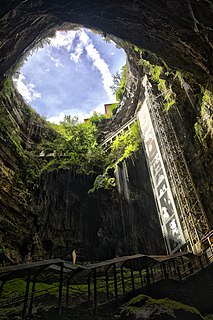 W
WThe caves of Arcy-sur-Cure are a series of caves located on the commune of Arcy-sur-Cure, Burgundy, France. Some of them contained archaeological artefacts, from the Mousterian to Gallo-Roman times.
 W
WAven Armand is a limestone cave located in the Cévennes National Park of France, in the Lozère département, between Meyrueis and Sainte-Enimie known for the tallest known stalagmite of 30 meters.
 W
WLes Combarelles is a cave in Les Eyzies de Tayac, Dordogne, France, which was inhabited by Cro-Magnon people between approximately 13,000 to 11,000 years ago. Holding more than 600 prehistoric engravings of animals and symbols, the two galleries in the cave were crucial in the re-evaluation of the mental and technical capabilities of these prehistoric humans around the turn of the last century.
 W
WThe Grotte des Demoiselles is a large cave located in the Hérault valley of southern France, near Ganges, about 60 km (37 mi) west of Nîmes. Its entrance is located on the territory of the commune of Saint-Bauzille-de-Putois.
 W
WFont-de-Gaume is a cave near Les Eyzies-de-Tayac-Sireuil in the Dordogne départment of south-west France. The cave contains prehistoric polychrome cave paintings and engravings dating to the Magdalenian period. Discovered in 1901, more than 200 images have been identified in Font-de-Gaume.
 W
WLes Grottes Pétrifiantes de Savonnières, also known as the caves gouttières, are two grottoes located in Savonnières, Indre-et-Loire, France.
 W
WLa Verna is a show cave in the commune of Sainte-Engrâce in the department of Pyrénées-Atlantiques in France. 660 metres (2,170 ft) of mined tunnel leads into the Salle de la Verna, the largest chamber in a show cave in the world. It has a diameter of 250 metres (820 ft), a height of 194 metres (636 ft), a surface area of 5 hectares and a volume of 3.6 million cubic metres (130,000,000 cu ft). A river cascades into the chamber from halfway up the east wall, and sinks into boulders near the base of the chamber.
 W
WThe Cave of Niaux is located in the Niaux commune, Ariège département in south-western France as part of a wider geological system that includes the Sabart Cave and Lombrives Cave in the hill of Cap de la Lesse de Bialac. The Niaux cave's system is complex and has a combined length of more than 14 km (8.70 mi) of underground passages and chambers. An archaeological site with a documented history of Paleo-human presence, Niaux contains numerous distinct areas and galleries of carefully drawn and vivid wall paintings, executed in a black-outlined style typical of the classic Magdalenian period, between 17,000 and 11,000 years ago.
 W
WAven d'Orgnac is a cave located near Orgnac-l'Aven, in the Ardèche département, France.
 W
WThe Padirac Chasm is a cave located near Gramat, in the Lot department, Occitanie region, France.
 W
WPech Merle is a cave which opens onto a hillside at Cabrerets in the Lot département of the Occitania region in France, about 32 km by road east of Cahors. It is one of the few prehistoric cave painting sites in France that remain open to the general public. Extending over 2 kilometres over two levels, of which only 1,200 m (3,900 ft) are open to the public, are caverns, wells and sloping tunnels, the walls of which are painted with dramatic murals dating from the Gravettian culture. Some of the paintings and engravings, however, may date from the later Magdalenian era.
 W
WThe Rouffignac cave, in the French commune of Rouffignac-Saint-Cernin-de-Reilhac in the Dordogne département, contains over 250 engravings and cave paintings dating back to the Upper Paleolithic.
 W
WThe Villars Cave, in French Grotte de Villars or Grotte du Cluzeau, was occupied during the Lower Magdalenian by Cro-Magnon hunter-gatherers. The cave is part of the French commune of Villars in the northern Dordogne département. Besides its enormous wealth in beautiful stalactites, stalagmites and similar calcite deposits it contains cave paintings and some engravings. The Villars Cave and the Rouffignac Cave are the biggest known cave systems in the Dordogne.